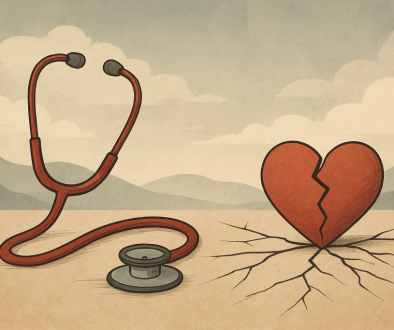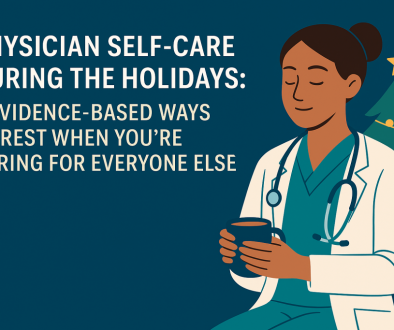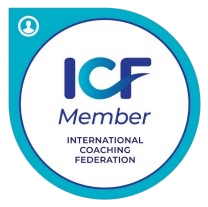Reclaiming Balance: Stress Management for Physicians
Have you ever found yourself staring at the ceiling at 3 AM, mind racing, worried and patients and administrative tasks, and the growing fear that you’ve forgotten why you became a doctor in the first place? If so, you’re not alone. I’ve been there too.
The Hidden Truth About Physician Burnout That No One Talks About
Imagine waking up each day feeling energized and eager to tackle the challenges ahead. As physicians, it’s easy to forget that you ca have a fulfilling and challenging medical career. The reality is that over 50% of physicians report symptoms of burnout, with many more experiencing chronic stress that hasn’t yet reached the burnout threshold.
But here’s what I’ve discovered after years of both experiencing and studying stress management for physicians: almost everything we’ve been taught about managing stress in our medical careers is fundamentally wrong.
We’re told to practice more mindfulness, exercise regularly, or take vacations. While these recommendations aren’t bad, they treat the symptoms rather than addressing the root causes of why stress management for physicians is uniquely challenging.
Why Traditional Approaches to Stress Management for Physicians Fall Short
As doctors, we face pressures unlike those in any other profession. Lives depend on our decisions. Systems constrain our autonomy. And the culture of medicine itself often celebrates self-sacrifice over self-preservation.
The standard advice about how to manage stress as a doctor often comes from those who haven’t worn a white coat. They don’t understand the guilt that comes with leaving the hospital “early” or the constant mental burden of wondering if you missed something critical during your last shift.
This is why generic wellness advice rarely works for physicians. We need solutions designed specifically for the medical landscape—burnout prevention strategies that account for the unique challenges we face.
The Three Pillar Approach: My Framework for Physician Wellness
Through my journey from burnout to balance, I’ve developed what I call the Three Pillar Approach to mastering wellness for healthcare providers. This isn’t theory—it’s a practical framework based on what actually works in the trenches of modern medicine.
Pillar 1: Restructuring Your Mindset – The Most Essential Skill for Doctors Not Taught in Medical School
The first pillar involves a fundamental shift in how you think about stress and your relationship with medicine. We spend years learning to diagnose rare diseases but receive zero training on how our thoughts create our experience of medical practice.
The truth is that your stress isn’t coming from external circumstances—not from difficult patients, overwhelming EMR systems, or demanding administrators. It comes from your thoughts about these circumstances.
This isn’t about positive thinking. It’s about recognizing that when you change your thinking, you change your experience. I’ve seen physicians transform their relationship with medicine without changing jobs or reducing hours, simply by addressing their thought patterns.
Action step: For one week, notice when you feel stressed and write down the exact thought causing that feeling. Don’t try to change it yet—just become aware.
Pillar 2: Eliminating the “Should” List – The Secret to Achieving Work-Life Balance in Medicine
The second pillar addresses the tyranny of “should” that plagues so many physicians. We carry mental lists of things we should be doing, ways we should be performing, and standards we should be meeting, most of which are arbitrary or impossible.
These “shoulds” create constant tension between our reality and an idealized version of physician life that doesn’t exist. They’re the primary obstacle to achieving work-life balance in medicine.
One of my clients, a cardiologist, realized she was carrying 27 different “shoulds” about being a perfect doctor, mother, spouse, and colleague. No wonder she felt perpetually inadequate! By challenging and eliminating these “shoulds,” she reclaimed control over her definition of success.
Action step: Identify your top three “shoulds” that create the most stress, and ask yourself: “Is this actually true? Who would I be without this belief?”
Pillar 3: Protecting Your Time – Practical Strategies to Overcome Physician Burnout
The final pillar addresses the practical reality that as physicians, our time is constantly under siege. Effective stress relief for healthcare professionals requires deliberate boundaries around your most precious resource.
This means learning to say no without guilt, creating systems that protect your time, and prioritizing activities that replenish rather than deplete you. For many physicians, this pillar represents the biggest challenge but also offers the most immediate relief.
I teach my clients specific scripts for declining commitments, templates for efficient communication, and strategies for creating “time boundaries” that preserve space for rest and recovery.
Action step: Identify one area where you consistently give away your time against your better judgment, and create a specific plan to establish a boundary.
Beyond DIY: When Physician Well-being Resources Make the Difference
While self-directed efforts are valuable, there’s immense power in accessing specialized physician well-being resources. Working with someone who understands the unique pressures of medicine can accelerate your journey from surviving to thriving.
This is why I created my coaching program and online course “Mastery and Wellness: How to Thrive as a Physician.” These resources provide the structure, accountability, and specialized tools that make sustainable change possible.
The program includes evidence-based strategies for stress reduction, burnout prevention, and career satisfaction that can be implemented alongside your clinical responsibilities. It’s designed as an ultimate guide to thriving as a physician in today’s challenging healthcare environment.
Mastery and Wellness: How to Thrive as a Physician
Understanding the multiple demands on your time, I’ve also developed an online course for physicians that allows you to earn category 2 CME credits while learning these essential wellness skills. This dual-purpose approach recognizes that your professional development and personal wellbeing shouldn’t compete for your limited time.
This courses cover everything from communication techniques to boundary-setting strategies to cognitive reframing—all while satisfying your continuing education requirements.
Taking the First Step Toward Transformation
The journey from burnout to balance doesn’t happen overnight, but it does happen—I’ve witnessed it countless times, both in my own life and in the lives of physicians I’ve coached.
The most important thing to understand is that physician burnout isn’t inevitable. With the right approach to stress management for physicians and targeted strategies to overcome physician burnout, you can reclaim the joy and purpose that brought you to medicine in the first place.
I invite you to take one small step today. Whether that’s trying one of the action steps I’ve shared, exploring the resources on my website, or reaching out for a consultation, movement in any direction breaks the inertia of burnout.
Remember: your wellbeing isn’t an indulgence—it’s a clinical necessity for providing the best care to your patients. By prioritizing effective stress management for physicians, you’re not just helping yourself; you’re upholding the highest ideals of our profession.
Ready to transform your relationship with medicine? Explore my physician coaching services and online courses today, and take the first step toward a sustainable, fulfilling medical career. Your future self and your patients will thank you.
—
Dr. Ben Reinking is a practicing physician and certified coach specializing in physician wellness and burnout prevention. Through The Developing Doctor, he provides coaching, online courses designed specifically for healthcare providers seeking to thrive in modern medicine.





